Planetary Science Missions
Future
- Rosalind Franklin (ExoMars) 2028
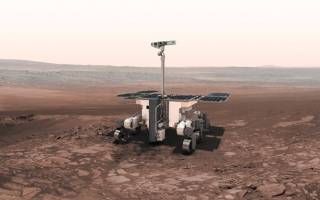
MSSL leads the team providing the Panoramic Stereo Cameras for ESA's Rosalind Franklin (ExoMars) 2028 rover mission, and are also helping build the Enfys infrared instrument.
The Rosalind Franklin Rover is a joint mission between ESA and NASA. MSSL leads the PanCam team to provide the rover's scientific ‘eyes’, and are contributing to the complementary Enyfs infrared spectrometer. The Rosalind Franklin Rover is scheduled to launch in 2028 and arrive at Mars in 2030. It will drill up to 2m below the harsh Martian surface to search for signs of past, or even present, life.
PanCam includes two Wide Angle Cameras (WACs) and a High Resolution Camera (HRC). The WACs are spaced 50cm apart for better stereo vision than our human eyes, and each has an 11-position filter wheel for colour images and to provide geological and atmospheric science. The HRC will look closely at rocks to determine texture. Enfys will look at part of HRCs field of view, providing infrared spectra to help with mineral identification. Together, PanCam and Enfys help set the context, and help the mission team decide where to drill.
The Martian environment presents the main technological challenge facing PanCam. Because the instrument is mounted on the rover mast, it is exposed to fine dust which settles from the atmosphere and is exposed to a difficult thermal environment. On Mars, temperatures may fall as low as -120C depending on latitude and season, and there is, like on Earth, constant diurnal cycling during the 24 hour 37 minute ‘sol’, with warmer temperatures during the day and colder temperatures at night. Even near the equator, at the rover’s Oxia Planum landing site, the range is quite extreme: perhaps as "warm" as 0-10 °C during the day, but falling to -90 to -100 °C at night. The PanCam and Enfys teams need to ensure that electronics and mechanical parts maintain reliable operation throughout the 218 sol mission.
Like the rest of the rover, PanCam and Enfys have planetary protection challenges, for example ensuring that we do not contaminate the Martian surface, not only because we want to be good planetary neighbours, but also so we do not affect the results of the sensitive biological and chemical analyses to be performed on-board.
- Comet Interceptor
- Comet Interceptor is an ambitious European Space Agency mission, working in collaboration with the Japanese Space Agency JAXA, to visit for the first time a long-period comet or interstellar object. The project comprises three spacecraft that will travel in parallel through the comet's coma. The mission's science consortium is led from MSSL, as is the EnVisS all-sky coma mapping instrument. Launch will occur in 2029. The mission science team's website is here (external link).
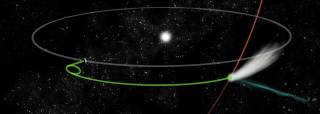
- Vera C. Rubin Observatory
- VRO, formerly known as LSST - The Large Synoptic Survey Telescope - is under construction in Chile. This highly capable ground-based telescope is being built to rapidly survey the night-time sky. MSSL scientists will study images of comets taken by the observatory to learn more about their ion and dust tails, revealing information on solar wind conditions at these objects, and tracking their dust ejection activity. More information on the observatory is available at this external site.
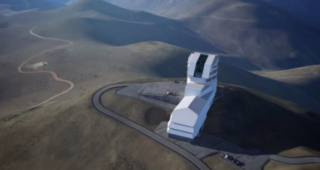
- Euclid
- Euclid is an ESA mission to map the geometry of the dark Universe. MSSL is playing a key role in the provision of the VIS instrument for this space observatory. In the Planetary Group, we intend to study solar system objects such as comets and asteroids that will appear in the foreground of the Euclid images of the far Universe.

- Canadian Lunar Rover mission (CLM)
- More information coming soon.

- M-Matisse
- More information coming soon.

Current
- Jupiter Icy Moons Explorer (JUICE) (2023-)
- The JUpiter ICy moons Explorer (JUICE) is a European Space Agency (ESA) mission, and the first large-class mission in the ESA Cosmic Visions 2015-2025 programme. The mission launched successfully on April 14, 2023. It will reach Jupiter in July 2031. Six months before entering orbit around Jupiter, Juice will begin its nominal science phase. The spacecraft will go on to spend many months orbiting Jupiter, completing fly-bys of Europa, Ganymede and Callisto, and finally conducting an orbital tour of Ganymede. MSSL has provided hardware for the mission's Particle Environment Package (PEP), led by the Stas Barabash of the Swedish Institute of Space Physics in Kiruna. We also have science co-investigator roles on the spacecraft's JANUS camera, led by P. Palumbo of Università degli Studi di Napoli, Italy. More information is available here.
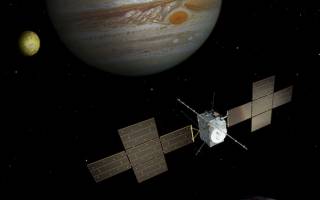
- Perserverance (2020-)
- The NASA Perseverence rover landed on Mars in February 2021. It is searching for signs of life, and will cache rock core samples on the surface for return to Earth by the NASA-ESA Mars Sample Return mission in 2026. We are co-investigator on the scientific camera Mastcam-Z, which provides stereo and zoom images to study Mars's geology and atmosphere. Our ExoMars PanCam team helped with filter selection and stereo processing.
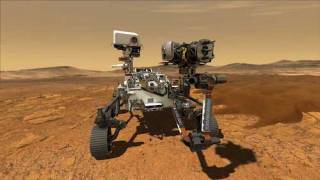
- Solar Orbiter (2020-)
- Solar Orbiter is a mission primarily designed to study the Sun and heliosphere. The mission's powerful range of instruments also gather valuable data on planets, comets, and dust, which we are studying within the Planetary Group. More information is available here.
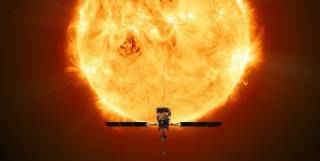
- BepiColombo (2018-)
- The ESA-JAXA BepiColombo mission will reach Mercury in 2025. It has two spacecraft - the ESA Mercury Planetary Orbiter and the JAXA Mercury Magnetospheric Orbiter, named Mio. MSSL are co-investigator on the Mercury Plasma and Particle Experiment (MPPE) on Mio, contributing to early design
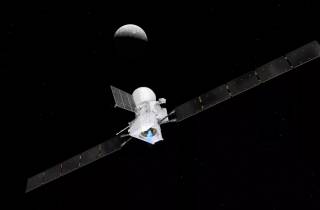
- Mars Express (2003-)
- Mars Express is an European Space Agency spacecraft that has continued to operate successfully since 2003. It delivered the Beagle-2 lander to the planet. MSSL contributed to the mission's ASPERA-3 instrument providing blackening and calibration for the electron spectrometer. More information is available here.
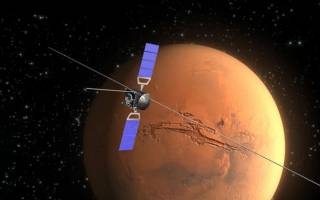
- XMM Newton (1999-)
- MSSL contributed to several aspects of XMM-Newton, in particular the Optical Monitor (OM) and the Remote Grating Spectrometer (RGS) instruments. The spacecraft has made possible observations of X-ray sources of all types. In the Planetary Group, we study X-ray observations of the outer planets, to learn more about these planets' aurora and their links to processes in the solar wind and these planets' magnetospheres. More information is available here.
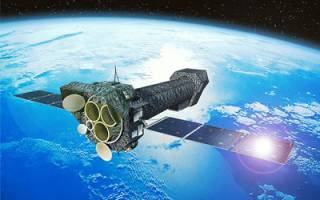
- Chandra X-ray Observatory (1999-)
- The NASA Chandra X-ray Observatory is an X-ray telescope operating in Earth orbit. In addition to its many astrophysical targets, the observatory has also provided invaluable data on bodies in our Solar System. Planetay Group scientists study planetary observations made using this spacecraft to learn more about outer planet X-ray missions, which primarily emanate from auroral regions.
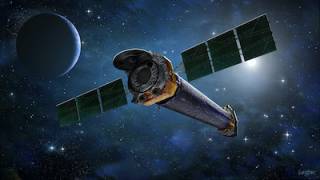
Past
- Cassini-Huygens (1997-2017)
- Cassini-Huygens was an incredibly successful joint mission to Saturn and its moons between NASA, the European Space Agency, and the Italian Space Agency. MSSL led the design and manufacture of the Cassini Electron Spectrometer element of the CAPS instrument that was carried on the Cassini orbiter. The analysis of data from that instrument continues, with new discoveries continuing to be made in relation to Saturn's magnetosphere, Titan's ionosphere, and the interactions between the planet's moons and their surroundings. CAPS-ELS detected negative ions in several regions of the Saturn system. The group also has a scientific role in the Cassini MIMI instrument.
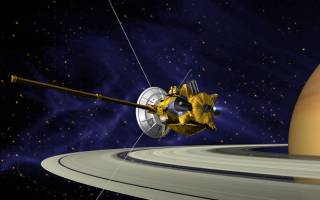
- Venus Express (2005-2014)
- Venus Express was ESA's first mission to Earth's closest planetary neighbour, Venus. MSSL made contributions to the ASPERA instrument carried aboard the spacecraft, which returned valuable data on the interaction between Venus and the solar wind. Analysis of this dataset continues. More information is available here.
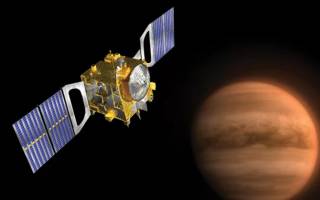
- Rosetta (2004-2016)
- The ESA Rosetta mission accompanied comet Churyumov-Gerasimenko on its journey around the Sun between 2014 and 2016. MSSL were co-investigator on the Rosetta Plasma Consortium, advising on instrument design, studying pickup ions near the comet, and carried out ground-based observations of the comet.
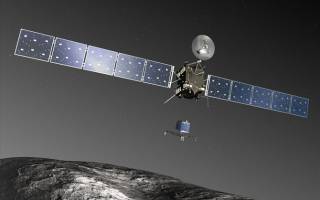
- Mars-96 (1996)
- Mars-96 was a highly ambitious Russian-led mission that would have delivered two soft landers, a surface penetrator, and a highly-capable orbiting spacecraft to Mars. MSSL led the FONEMA plasma instrument, that would have allowed the study of atmospheric escape in the vicinity of the planet. Unfortunately, the craft failed to leave orbit, and re-entered the Earth's atmosphere. Building FONEMA provided a wealth of additional experience in building highly-capable plasma detectors for planetary space missions.
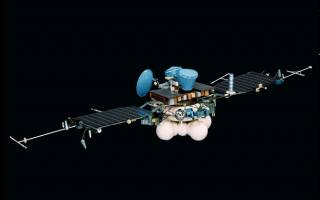
- Beagle-2 (2003)
- Beagle-2 was a UK-led Mars lander that was delivered to the planet by the ESA Mars Express spacecraft. MSSL provided the lander's stereo camera system. The craft landed on Mars on 25 December 2003, but in images obtained from martian orbit, appears to have not fully deployed on the surface, preventing the lander from sending scientific data to Earth.
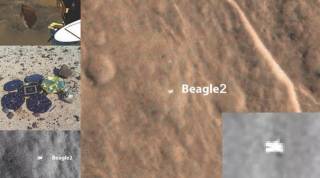
- Giotto (1985-1992)
- Giotto was the European Space Agency's first interplanetary mission, and was part of the international armada of spacecraft which made flybys of Comet 1P/Halley in 1986. Following its encounter with Halley, the spacecraft was put into hibernation. It was reawoken to make a close approach of Earth in 1990, which enabled it to make a flyby of Comet Grigg-Skjellerup in July 1992. The Johnstone Plasma Analyser (JPA), led from MSSL, captured valuable data revealing details of the process through which has from a comet joins the flow of the solar wind. More information is available here.
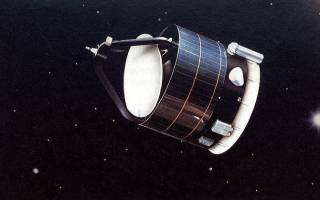
Past Mission Proposals
- Akon Penetrator (2016)
- This proposal to ESA, led by MSSL, was for an instrumented penetrator to be delivered to the surface of Jupiter's moon Europa by the NASA Europa Lander mission. Following descent and a high-speed impact at 300 m/s, instruments inside the craft would have gathered unique data on the near-subsurface of this intriguing, water-ice-covered moon.
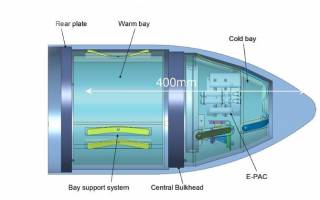
- Castalia (2015 and 2016)
- The aim of the Castalia mission was to explore a Main Belt Comet (MBC) - a body in the asteroid belt that contains ice. The mission was proposed twice to the European Space Agency, with one of these proposals led from MSSL. Studying an example of this recently discovered solar system minor body would allow us to learn more about the distribution of volatiles in the early stages of planet formation, and the links between water and organics in the asteroid belt ultimately with life on Earth.
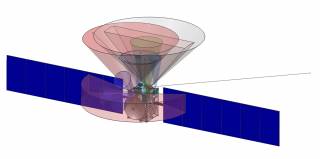
- Uranus Pathfinder (2010)
- UP was an MSSL-led proposal for a European Space Agency-led mission to the planet Uranus. This multi-disciplinary mission would have carried out the first survey of the planet, moons and magnetosphere of the seventh planet since the brief Voyager 2 flyby in 1986.
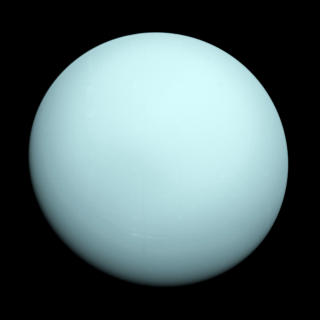
- Caroline (2010)
- The Caroline mission would have captured and returned to Earth a sample of dust from a Main Belt Comet (MBC). The proposal to the European Space Agency was led from MSSL. Studying this recently discovered class of minor bodies in the solar system would allow us to learn more about the distribution of volatiles in the early stages of planet formation, the link between water and organics in the asteroid belt, and life on Earth.
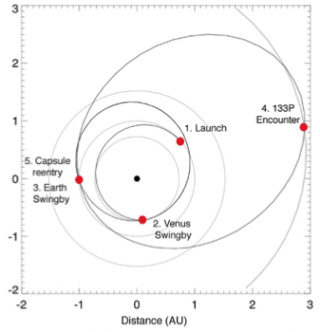
 Close
Close

